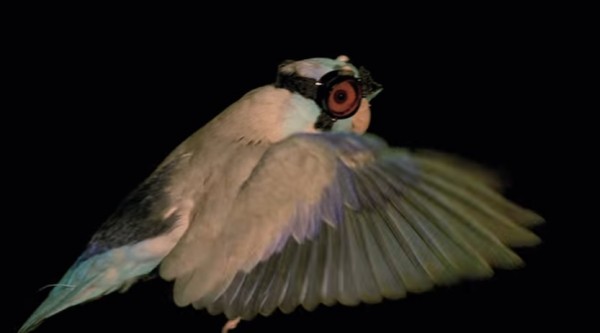By Ana Verayo, | December 06, 2016

Stanford researchers have trained birds to wear safety goggles and fly through a laser sheet as part of an experiment. (YouTube)
Scientists are working with lasers and a small bird wearing cute safety goggles to develop animal-inspired aircraft technology.
The tiny parrotlet named Obi has customized safety goggles that protect his eyes when he flies through a sheet of laser, as a Stanford team has trained him to do so.
Like Us on Facebook
Researchers at the Stanford University's Lentink Lab are studying air movement during a bird's initial flight takeoff. The team has identified crucial flight factors based on Obi and three flight models.
According to Diana Chin of Stanford's Lentink Lab, the goal of this new study is to compare common models to figure out how much lift a bird or any flying animal can generate based from its wake. The three common wake models are apparently inaccurate due to previous assumptions.
While testing these models, the team trained Obi to fly from one position and perch on another while wearing the goggles. A laser sheet was then seeded with nontoxic aerosol particles so that when Obi flies through the laser sheet, the disturbed particles will reveal swirling vortices from his wake.
Past studies and models suggest that these vortices remain stationary after a bird passes through air, similar to airplane contrails. However, this new research revealed that the vorticles break up quickly in a violent manner after the bird flies through.
According to the senior author of the study, mechanical engineering professor David Lentink of Stanford University, vortex breakups occur very far away from an aircraft, at thousands of meters away, but in birds, it occurs very close to the bird's body within two or three wingbeats, becoming much more violent.
The team tested three traditional models which yielded inaccurate predictions of the parrotlet's wings.
Researchers plan to conduct more tests and flight research on different bird species and other animals like bats and insects to develop flying robots that use actual wings as opposed to rotors.
This new study was published in the journal, Bioinspiration and Biomimetics.
-
Use of Coronavirus Pandemic Drones Raises Privacy Concerns: Drones Spread Fear, Local Officials Say

-
Coronavirus Hampers The Delivery Of Lockheed Martin F-35 Stealth Fighters For 2020

-
Instagram Speeds Up Plans to Add Account Memorialization Feature Due to COVID-19 Deaths

-
NASA: Perseverance Plans to Bring 'Mars Rock' to Earth in 2031

-
600 Dead And 3,000 In The Hospital as Iranians Believed Drinking High-Concentrations of Alcohol Can Cure The Coronavirus

-
600 Dead And 3,000 In The Hospital as Iranians Believed Drinking High-Concentrations of Alcohol Can Cure The Coronavirus

-
COVID-19: Doctors, Nurses Use Virtual Reality to Learn New Skills in Treating Coronavirus Patients







